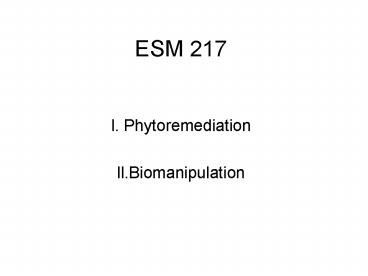ESM 217 - PowerPoint PPT Presentation
1 / 30
Title:
ESM 217
Description:
Phytoremediation is a process that uses plants to remove, transfer, ... Plants: indian mustard, sunflower, tabacco ... Plants: Poplars, alfalfa, indian mustard ... – PowerPoint PPT presentation
Number of Views:162
Avg rating:3.0/5.0
Title: ESM 217
1
ESM 217
- l. Phytoremediation
- ll.Biomanipulation
2
Phytoremediation
- Phytoremediation is a process that uses plants to
remove, transfer, stabilize, or destroy
contaminants in soil, sediment, and groundwater
3
Phytoremediation
4
Phytoremediation
- Applies to all biological, chemical, and physical
processes that are influenced by plants
(including the rhizosphere) and that aid in
cleanup of the contaminated substances - Plants can be used in site remediation, both
through the mineralization of toxic organic
compounds and through the accumulation and
concentration of heavy metals and other inorganic
compounds from soil into aboveground shoots - Phytoremediation may be applied in situ or ex
situ, to soils, sludges, sediments, other solids,
or groundwater.
5
Mechanisms
- Phytoextraction the uptake of contaminants by
plant roots and the translocation/accumulation of
contaminants into plant shoots and leaves
- Used to treat soil, sediments, sludge, and
contaminated water - Good for Ag, Cd, Co, Cr, Cu, Mn, Mo, Ni, Pb, and
Zn - Plants indian mustard, sunflower, tabacco
- Advantages plant biomass with contaminant
extracted contaminant can be a resource
elsewhere often cheaper than extraction
(excavation, washing, incineration) - Disadvantages metals hyperaccumulators often
grow slowly small biomass shallow root system
metal reclamation and disposal costly - Thalspi rotundifolium in Pb-Zn mine area 0.82
Pb, 1.73 Zn.
6
Mechanisms
- Phytoextraction
7
Mechanisms
- rhizosphere biodegradation breakdown of an
organic contaminant in soil through microbial
activity enhanced by the root zone. Takes place
in soil or groundwater immediately surrounding
plant roots
- Used to treat soil, sediments, sludge, and
contaminated water - Good for PAHs, TPH, pesticides, herbicides, BTEX
- Plants red mulberry, crab apple, spearmint,
rice, bush bean - Advantages in situ destruction of contaminants,
mineralization tightly binds, cheap. - Disadvantages development of root system slow,
root depth limited by physical barriers, may need
fertilization
8
Mechanisms
- rhizosphere biodegradation
9
Mechanisms
Phytodegradation, the metabolism of contaminants
within plant tissues
- Used to treat soil, sediments, sludge, and
contaminated water - Good for chlorinated solvents, herbicides,
insecticides, munitions (TNT) - Plants parrot feather and stonewort (aquatic),
poplar, back willow, live oak - Advantages in situ sequestration of
contaminants, mineralization tightly binds,
cheap. - Disadvantages plant growth rate may limit
utility, may have to dispose of plants before
bioaccumulated by grazers, may need fertilization
10
Mechanisms
Phytodegradation
- Metabolism within plant
- Production of the dehalogenase
- and oxygenase enzymes,
- catalyzes degradation
Contaminant uptake
11
Mechanisms
- Rhizofiltration adsorption or precipitation onto
plant roots, or adsorption into roots of
contaminants that are in solution surrounding the
root zone due to biotic or abiotic processes.
- Used to treat soil, sediments, sludge, and
contaminated water - Good for Pb, Cd, Cr, Ur, Cu, Ni, Sr
- Plants red mulberry, crab apple, spearmint,
rice, bush bean - Advantages in situ sequestration of
contaminants, mineralization tightly binds
chemicals, cheap. - Disadvantages development of root system slow,
root depth limited by physical barriers, may need
fertilization - Pilot-scale projects only
12
Mechanisms
- Phytostabilization immobilization of
contaminated soil through absorption and
accumulation by roots, adsorption on to roots, or
precipitation within root zone, or use of plant
roots or plant to prevent migration via wind,
water, erosion, leaching, soil dispersion
- Used to treat soil, sediments, sludge
- Good for Zn, Pb, Cu, Cr, Cd
- Plants metal tolerant spp red fescue, bentgrass
- Advantages soil removal is unnecessary lower
cost and less disruptive than other soil
remediation technologies- washing, leaching
disposal of hazardous material or biomass not
necessary cheap ecosystem restoration possible - Disadvantages contaminants remain in place-
long-term maintenance fertilization soil
modification must prevent above ground movement
13
Mechanisms
- Phytovolatization uptake and transportation of a
contaminant by a plant, with releases of
contaminant or modified form to the atmosphere
- Used to treat ground water, soil, sediments,
sludge - Good for Hg, Se, TCE, CTC
- Plants Poplars, alfalfa, indian mustard
- Advantages contaminants transferred to less
toxic forms. - Disadvantages hazardous materials can be
released as gas stored in plant uptaken by
grazers
14
Mechanisms
- Phytovolatization
15
Mechanisms
- Hydraulic control
Poplars and cottonwoods
16
Mechanisms
- Vegetation cover
17
Mechanisms
- Vegetation cover
18
Mechanisms
- Riparian corridors/buffer strips generally
applied along streams, rivers banks, wetland
edges to control and remediate surface runoff and
groundwater contamination moving into water body
- Used to treat surface and ground water runoff
- Good for water borne contaminants and nutrients
- Plants Poplars, wetland plants (Spartina spp.),
water uptake and plant metabolism incorporates
hydraulic control, phytodegradation,
rhizodegradation, phtyovolatization, and
phytoextraction - Advantages stabilizes banks, creates habitat
- Disadvantages hazardous materials can be
released as gas stored in plant uptaken by
grazers
19
Mechanisms
- Riparian corridors/buffer strips
20
(No Transcript)
21
(No Transcript)
22
(No Transcript)
23
Limitations of phytoremediation?
- Population level the plant
- Community level- species interactions
- Landscape levels- climate
24
http//www.clu-in.org/download/remed/introphyto.pd
f
25
ll. Biomanipulation
26
Biomanipulation in northern lakes
- Trophic cascade
Historically normal food web
Piscivores
planktivores
herbivores
phytoplankton
PO4
nutrients
27
Biomanipulation in northern lakes
planktivores
Modern food web
herbivores
phytoplankton
PO4
nutrients
28
Biomanipulation in northern lakes
Some lakes restocked
Piscivores
planktivores
herbivores
phytoplankton
PO4
nutrients
29
Biomanipulation in northern lakes
Biomanipulation restock eutrophied lakes with
piscivores
PO4
30
Other examples?































